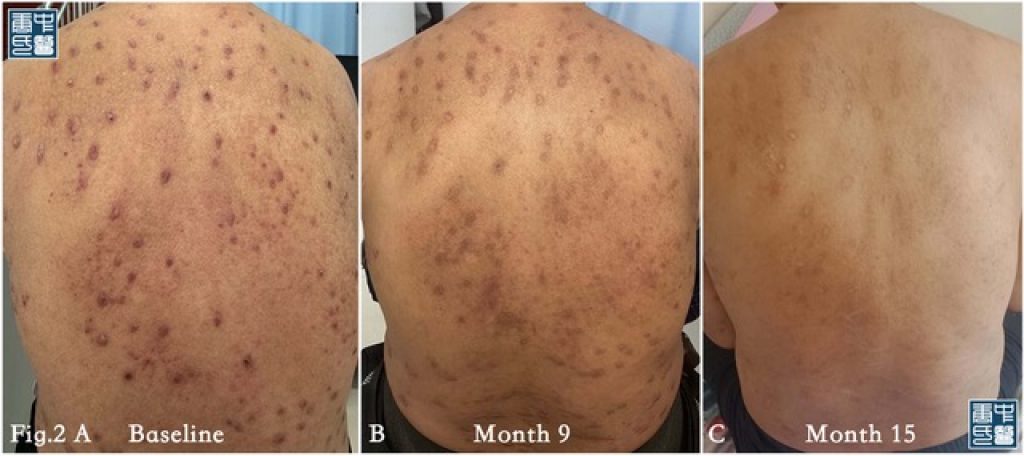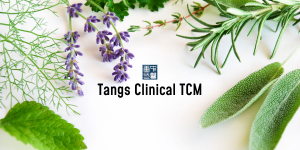A 64-year-old man with 15-year history of Prurigo Nodularis 64岁罹患结节性痒疹15年
Chronic pruritus (itch) is defined as ‘an unpleasant sensation leading to the desire to scratch lasting at least 6 weeks [1,2]. Secondary scratch lesions occur frequently, and if chronic, may form certain typical clinical presentation as prurigo nodularis (PN). Nodules in PN are also intensely itchy and thus a vicious itch–scratch–cycle may evolve resulting in longlasting and highly therapy refractory PN. It is estimated that the prevalence of PN is 1–2.5/10 000 persons in the USA and the UK [3]. Prurigo nodularis affects patients across all ages, including children [4], but is more common in older patients [5].

Case Reports
We report a 64-year-old man without a history of atopy, but has nodule lesions on his arms, legs, trunk and scalp that had been presented for 15 years. He stated that they began to appear on his limbs days after a trip, he thought mosquito bites, but itch and lesion are persistent. Unkown therapy (topical cream and oral tablets) provided partial symptomatic relief, and control of the eruption was unable to be achieved after 10 years. Multiple nodules spread his trunk and scalp for recent 2 years.
Examination found hundreds of 2mm to 20mm in diameter discrete erythematous modules with symmetric distribution of the lesions on the extensor surfaces of the arms and legs and on the trunk and scalp (Fig.1A, Fig.2.A). Patient decleared no other diseases apart from PN. The medicinal products both topical and systemical previously administered are unknown.
Treatment was begun with herbal medicine Derma-zema herbal compound formulation administered in the standard dosing regimen. As patient located overeases, he reported numeric rating scale itch intensity (NRSi), measured on a scale of 0 to 10 (10 representing the worst possible itch) over the tele-communication, the photos self-taken were recorded before and after treatment. He reported an NRSi of 9 of 10 before initiating treatment with our herbal medicine. After 1 month of treatment, the patient’s reported NRSi was between 7 and 8, NRSi of 4 at month 9, at 15-month follow-up, the patient reported an NRSi of 0 (Fig.1I and Fig.2 C). The overall size and number of prurigo lesions decreased significantly (Fig.1I and Fig.2 C). No adverse events were reported during the 15 months follow-up.
Discussion
No therapies have been approved by the Food and Drug Administration for prurigo nodularis, and treatment is challenging. Nearly all patients failed to respond to topical glucocorticoids and antihistamines. Many patients also do not have a response to off-label use of systemic therapies such as methotrexate, cyclosporine and thalidomide which have undesirable side effects [6]. While the present case report is limited, the response following herbal treatment in this patient is encouraging. Our findings raise the prospect of a nonharmful botanical therapy for the treatment of PN, which deserves additional study.

Reference:
- Rothman S. Physiology of itching. Physiol Rev 1941;21:357–81
- Ständer S, Weisshaar E, Mettang T, et al. Clinical classification of itch: a posi- tion paper of the International Forum for the Study of Itch. Acta Derm Venereol 2007;87:291–4.
- Sonja Ständer and Malcolm Greaves In: Christopher Griffiths, Jonathan Barker, Tanya Bleiker, Robert Chalmers & Daniel Creamer, editors. Rook’s Textbook of Dermatology, 9th edition. Wiley Blackwell; 2016. p83.13
- Amer A, Fischer H. Prurigo nodularis in a 9‐year‐old girl. Clin Pediatr 2009;48:93-95
- Eigelshoven S, Homey B. Prurigo nodularis. CME Dermatol 2009;4:140–55
- Huang AH, Canner JK, Kang S, Kwatra SG. Analysis of real-world treatment patterns in patients with prurigo nodularis. J Am Acad Dermatol 2020;82:34-6.



